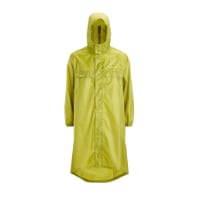I've just finished 350kms of the Camino de Santiago from St John Pied Port finishing in Burgos. Here is my take on what to take and not to take.
Sleeping Bags:
Take a liner and don't bother with a sleeping bag. Despite some cold weather we sweltered in the Alberques every night. Pack 20 people into a room and it warms up. I did not sleep in the bag one night.
The Pack:
We took the advice of people and bought 35 litre packs. I have a 70 litre pack. If I did it again I'd take the 70 litre. The smaller packs are such a nuisance to pack. We only carried 10kgs but in the small pack it always required a fiddle. Take the bigger pack and be happy for the space.
Also the bigger packs usually have a bottom section of about 25 litres separated from the bigger top. That structure in perfect. You'd pack most of what you need at nights in the bottom and seldom fiddle with the top.
The 35 litre drove me crazy because I had to unpack the entire thing everywhere.
Rain gear:
We had horrendous weather on the Pyrenees and I can tell you that ponchos are a complete waste of time as are those pack covers. Get a parka and pants and use a pack liner not a cover.
Weight:
There was one pilgrim with a 70 litter pack filled to capacity and a 20 litre pack on his front. He suffered. I've done a lot of walking. In the Wilderness you might have to carry 20 plus kgs but you don't walk as far. The additional weight will really spoil your experience.
Best item:
Keene sandals - I was able to wear them out at night with socks if it was cold.
So my list:
underpants and socks - 2 pairs
Shorts for walking with leggings if it cold
2 shirts
Rain gear
Long pants for evening while shorts get a wash
Fleece
Baselayer - 1 top and bottom.
Hat
Boots:
Boots are stiff - that means your foot does not bend like it does in a shoe. Your feet get less tired in boots.
Technical clothing:
Yes it's just easier. It dries quickly - still insulates when wet.
Sleeping Bags:
Take a liner and don't bother with a sleeping bag. Despite some cold weather we sweltered in the Alberques every night. Pack 20 people into a room and it warms up. I did not sleep in the bag one night.
The Pack:
We took the advice of people and bought 35 litre packs. I have a 70 litre pack. If I did it again I'd take the 70 litre. The smaller packs are such a nuisance to pack. We only carried 10kgs but in the small pack it always required a fiddle. Take the bigger pack and be happy for the space.
Also the bigger packs usually have a bottom section of about 25 litres separated from the bigger top. That structure in perfect. You'd pack most of what you need at nights in the bottom and seldom fiddle with the top.
The 35 litre drove me crazy because I had to unpack the entire thing everywhere.
Rain gear:
We had horrendous weather on the Pyrenees and I can tell you that ponchos are a complete waste of time as are those pack covers. Get a parka and pants and use a pack liner not a cover.
Weight:
There was one pilgrim with a 70 litter pack filled to capacity and a 20 litre pack on his front. He suffered. I've done a lot of walking. In the Wilderness you might have to carry 20 plus kgs but you don't walk as far. The additional weight will really spoil your experience.
Best item:
Keene sandals - I was able to wear them out at night with socks if it was cold.
So my list:
underpants and socks - 2 pairs
Shorts for walking with leggings if it cold
2 shirts
Rain gear
Long pants for evening while shorts get a wash
Fleece
Baselayer - 1 top and bottom.
Hat
Boots:
Boots are stiff - that means your foot does not bend like it does in a shoe. Your feet get less tired in boots.
Technical clothing:
Yes it's just easier. It dries quickly - still insulates when wet.



















